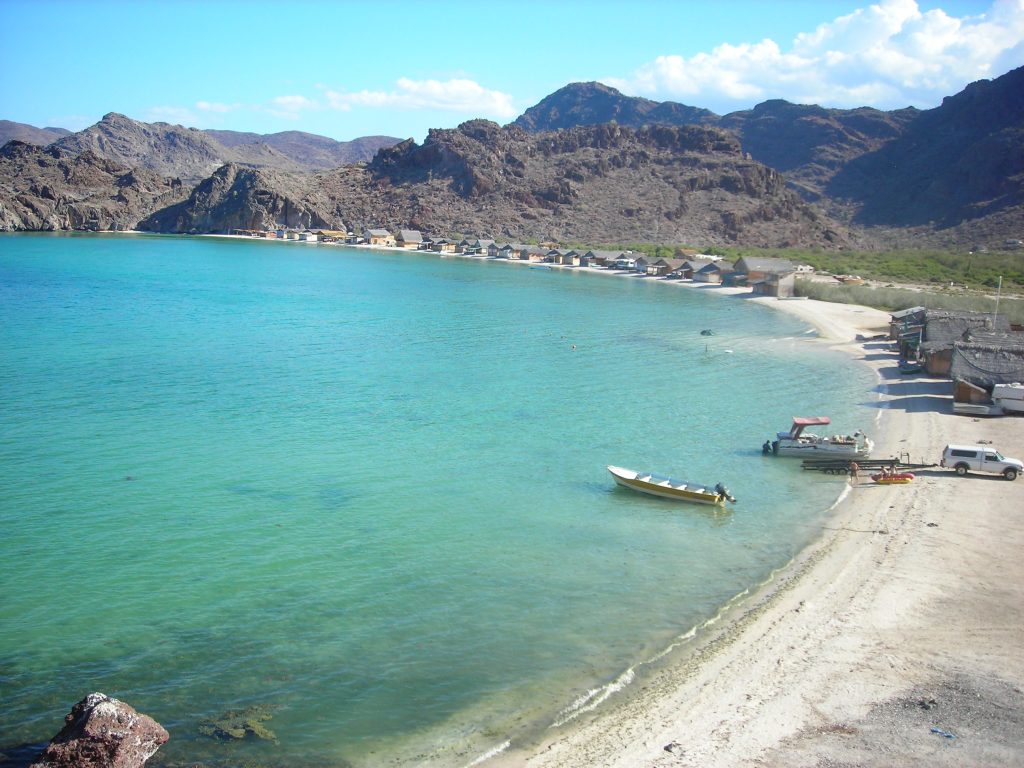Savor the Mediterranean of the west: Mexico’s long, slender arm of the Baja California Peninsula is embellished with rich turquoise water, white-sand bays and rugged ranges. On your next international adventure, road trip the Transpeninsular Highway, which runs more than 1,000 miles from Tijuana to Los Cabos, passes bizarre cacti and granite mountains, and is home to bottomless taco stands.
With more than 900 species of fish, the Gulf of California is the world’s aquarium and one of the most biologically diverse bodies of water in the world. Kayaking, stand up paddle boarding (SUP), surfing, deep-sea fishing, snorkeling, scuba diving, hiking and oceanside camping are all activities you can enjoy in this slice of paradise. And when you’re out of the water, check out authentic, little-known Mexican towns like Mulegé.

Bahía de Mulegé. Photo credit: Flickr.
“Mulegé is the real Baja. The locals are great, the oasis is beautiful, and south of Mulegé is Bahía Concepción, which reminds me of Greece. Dry, rocky, arid mountains fall into the white-sand beaches. It’s like the Mediterranean,” says Linda Nordstrom, senior producer at REI Media Studio, who recently explored Baja on a two-week road trip.
Nordstrom shares a handful of the best roadside attractions, towns, and landscapes along this south-of-the-border route.
Over the Border: Adventures on Highway 1
Adjacent to the city of Ensenada is La Bufadora sea geyser, a cave between two huge rocks that loudly expels water more than a hundred feet high when the waves crash upon it. The lookout above the cove is a great viewpoint for the spectacle, or hop in the water and paddle the kayaks. The local fisherman and property owner rents out land for campers. Here, and throughout Mexico, carry cash and plan to pay $5-$10 per camp spot. From abalone to sea urchin, fresh seafood from both oceans is served at Ensenada’s Mercado Negro, one of Mexico’s nationally renowned seafood markets.
Boojum trees belong to the imagination of Dr. Seuss. Natural to Mexico, the species can grow 50 feet or higher as its circular stem grows, splits and twists into odd shapes. As you head south, look for patches of the boojum forest on the arid landscape between El Rosario and San Antonio de las Minas.
After ongoing miles of desert, San Ignacio is a verdant oasis with flourishing date palms and citrus trees. Light blue and pale yellow buildings speckle town. The intimate plaza is overlooked by a 17th century mission, the San Ignacio de Loyola, which has an incredible facade and is built from volcanic rock. If you stay, Ignacio Springs bed and breakfast sits next to the San Ignacio River, where you can swim, SUP or kayak. Less than 40 miles to the south is a whale watching sanctuary, San Ignacio Lagoon, the last and only undeveloped nursery and breeding ground in the world for the Pacific Gray Whale.
In under an hour, you can drive from San Ignacio to volcán de las Tres Vírgenes, which is composed of three volcanoes named El Viejo (The Old Man), El Azufre (Sulfur) and La Vírgen (The Virgin). The reserve features hiking trails, cave paintings and hot geysers. Reach out to the Eco Tour Las Tres Vírgenes for advice and ask about guides with burros that can lead you to the canyon’s hieroglyphics.

View over Mulege oasis in Baja California Sur, Mexico. Photo credit: Adam Jones, Flickr.
Mulegé is Baja in rawest form. The outdoorsy oasis is dressed with date palms and mangroves, which are nourished by the small river that runs through town. South of the small community are the sandy, white beaches of Bahía Concepción, including the popular—though, solitary—beaches of El Coyote, El Requesón, Concepción and Los Cocos. Retired RV dwellers from the U.S. and Canada post up on the strips for long periods. It’s easy to see why they never want to leave. Grab your provisions—water and food—from the main store in Mulegé and camp on the beach. One option is to SUP or kayak from Playa El Burro to El Coyote, in the company of pelicans and seals, followed by a drink at Bertha’s Restaurant and Bar.
Malecón is the centerpiece of La Paz. The 3-mile promenade along the bay has sculptors—including a statue of Jacques Cousteau—museums, restaurants, little shops and taco stands. After a long stroll, there’s no shortage of incredible restaurants here. In the city, grab a tasting at La Miserable, a mezcalería. Fuel up with to-die-for baked goods and sandwiches at Doce Cuarenta Cafe, which boasts a cute patio. Find unbelievably fresh seafood at Mc-Fisher, and for a nice dinner out grab a table at Las Tres Vírgenes.
Espíritu Santo Island simply can’t be missed. These clear, deep and rich blue waters are a sanctuary for sea life. Kayak, snorkel, SUP, birdwatch, trek—do it all. The island, 16 miles off the coast, is a part of a UNESCO World Heritage site that comprises 244 islands and coastal areas. Spend more than one night on the island on a secluded beach at Baja Camp with luxurious tents, warm showers, fresh seafood and chilled cocktails.
When you turn off Highway 1 toward Santiago, follow the signs for the waterfalls to reach Rancho Ecológico, a rustic lodge owned by Don Prisciliano with an incredible rooftop view of the sunset, candlelit rooms, cold beers and amazing house-made meals. Bonus: Don’s dog leads visitors to the Sol De Mayo waterfall.
Todos Santos is a magical town dotted with art galleries, top-scale restaurants, quiet beaches, rows of textiles and artisan accommodations. One is Hotel California, an exclusive Mexican hacienda-style boutique with only 11 suites, a shop with locally made crafts and highly regarded restaurant.
